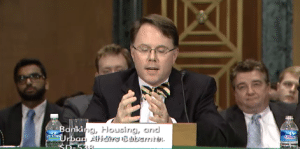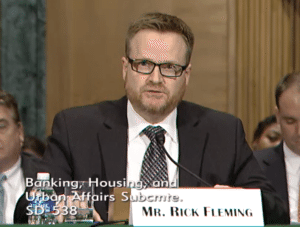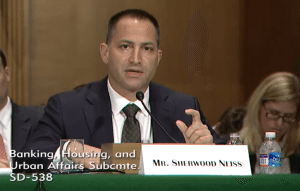 Yesterday the United States Senate Committee on Banking, Housing & Urban Affairs held a hearing entitled “The JOBS Act At A Year And A Half: Assessing Progress And Unmet Opportunities.”
Yesterday the United States Senate Committee on Banking, Housing & Urban Affairs held a hearing entitled “The JOBS Act At A Year And A Half: Assessing Progress And Unmet Opportunities.”
It was set to be a particularly interesting hearing because of the panel, which included two people who would certainly have opposing viewpoints on issues related to crowdfunding: Sherwood Neiss of Crowdfund Capital Advisors and The Startup Exemption, and NASAA President and Director of the Ohio Division of Securities Andrea Seidt. As it turned out Seidt wasn’t able to attend, so NASAA Deputy General Counsel Rick Fleming attended in her place.
Early discussion was dominated by Title IV of the JOBS Act, which Chris Brummer and Daniel Gorfine broke down in their recent article on the JOBS Act in Forbes…
Regulation A has permitted the sale of securities to both accredited and unaccredited investors so long as the issuer files a mini-registration with the SEC and complies with relevant state law requirements in each state where funds are solicited. One online issuer, Fundrise, has used this exemption to raise money from investors in Washington, D.C. and Virginia for a local commercial real estate project. Title IV of the JOBS Act increases the offering limit from $5 million to $50 million in a 12-month period, requires that certain filings be provided to investors, and provides for annual audited financial statements. This portion of the law requires SEC rulemaking before going live, which has to date not yet occurred. For the sake of clarity, lawyers and wonks tend to call this portion of the law: Reg A+ investing.
 Reg A+ was referred to as the least understood provision in the JOBS Act. Robert Kaplan Jr., Managing Partner at Kaplan Voekler Cunningham & Frank PLC, broke down his take on Regulation A+ in the following testimony…
Reg A+ was referred to as the least understood provision in the JOBS Act. Robert Kaplan Jr., Managing Partner at Kaplan Voekler Cunningham & Frank PLC, broke down his take on Regulation A+ in the following testimony…
Traditionally the dichotomy in capital raising in this country has been between public registration and private placement of securities, most commonly under Regulation D. The interesting thing about Regulation A, and in concert Regulation A+, is rather than being a transactional exemption, you’re exempting the securities themselves, so now we move away from the accredited investor requirements. We can engage in general solicitation. We also have a security that is freely tradeable, but this is done within the construct of regulatory oversight that can give the market confidence in the securities that are being sold.
What we have seen, and I alluded to this in my opening remarks, in the Reg D marketplace is that audience is shrinking, and we believe it’s going to shrink significantly more in light of some news that will be made regulatorily by the Commission based on suggestions by the GAO and others. We don’t speak to the wisdom of that – again, that’s the practical reality – but what Regulation A will allow is the ability to go to a broader audience, and we personally believe because of that standardized disclosure and the size of the deals and companies we are dealing with, there has been any number of brokerages and investment banks around this country that have been iced out – for lack of a better term – of the public IPO marketplace. There are somewhere just south of five thousand broker-dealers in the United States. And so, if you’re dealing with these main street businesses, as I’ve coined the phrase, you have the ability potentially to have placements done on a regional level. Being done on a regional level means an enhanced layer of transparency for the investor and the brokerage houses that work with these issuers. They’re going to be the subject of articles in the local business section of the local paper every day. They’re going to be on the news. So I think what’s really interesting about Title IV and really where the utility is going to be seen is the fact that you’re creating this intermediate level of securities which allows for a greater diversity of professional vendors, brokerages, analysts, news reporters – everybody to come to the marketplace and create a greater variety of securities for individuals.
 NASAA Deputy General Counsel Fleming stated that he conservatively takes 15 calls a week from issuers interested in Regulation A+. As to the question of whether issuers will make use of this new exemption, Fleming said, “yes, I believe the demand will be there,” albeit not the level of the Regulation D marketplace. He does believe Regulation A+ will result in a “very viable and working marketplace very quickly.”
NASAA Deputy General Counsel Fleming stated that he conservatively takes 15 calls a week from issuers interested in Regulation A+. As to the question of whether issuers will make use of this new exemption, Fleming said, “yes, I believe the demand will be there,” albeit not the level of the Regulation D marketplace. He does believe Regulation A+ will result in a “very viable and working marketplace very quickly.”
Fleming continued by clarifying that the NASAA is not raising a red flag on Regulation A+, and he alluded to the NASAA seeing it as a step forward. He cited state-level regulatory oversight as important to protecting investors while allowing companies to make use of the exemption, and expanded his comments to include all small business offerings.
“We think for small business offerings, it really should be the states that are kind of on the lead of that, and so Reg A creates an exemption under federal law and kind of leaves it to the states to be the primary regulators, which we think is a good thing – a good model that if we can be successful in Reg A maybe we can expand into other areas,” Fleming said. He said that in order for Regulation A+ to be successful, rules needed to be consistent state to state, rules need to make sense in the context of small business offerings, and there should be a one-stop filing system, which the NASAA is in the process of providing and ahead of the SEC’s progress on implementing final rules.
The NASAA began an official 30-day public comment period for Regulation A+ yesterday, a notice of which is available on their web site.
 Sherwood Neiss took issue with the supposition that state regulators are best-suited to provide oversight for exempt offerings. “I personally think that the regulators play an important role. However, if you look at the issuer and the size of the issuer and what they’re trying to do, there is just no way they can be compliant with filing with each of 50 states,” he said. “The bureaucracy and the cost would be too overwhelming for a small issuer to go out there.”
Sherwood Neiss took issue with the supposition that state regulators are best-suited to provide oversight for exempt offerings. “I personally think that the regulators play an important role. However, if you look at the issuer and the size of the issuer and what they’re trying to do, there is just no way they can be compliant with filing with each of 50 states,” he said. “The bureaucracy and the cost would be too overwhelming for a small issuer to go out there.”
“I think the answer is not looking at regulators as the people who are policing the market, even though they play that important role, but looking at technology as a solution for how we can efficiently build markets.”
Neiss continued to say that the storage of information online will be an important tool for state regulators, and that stored information can serve to inform their decisions on whether issuers are staying on the right side of the rules without requiring 50-state registration.
On the subject of the much-maligned 15-day Form D filing period for generally solicited offerings, Fleming said that 15 days advance notice would be unnecessary for state regulators. He clarified that any advance notice short of 15 days would be enough. A current problem facing state regulators is the act of solicitation with no notice whatsoever. Fleming stated that state regulators cannot properly vet the validity of a generally solicited offering in the absence of a filing. “There’s no real way that we can tell at a glance” whether issuers are operating under these new exemptions, he said.
Sherwood Neiss was asked how to properly balance investor protection and capital formation, and he offered two thoughts on the matter. The first dealt with the cost of capital, and specifically dealing with newly-proposed thresholds triggering mandated accounting and – for issuers seeking over $500,000 under Section 4(a)(6) – full mandated audits.
“Those types of requirements are onerous and the cost of capital will come out of the money that is raised, so I don’t think if 10% of a $500,000 offering goes to an audit outside of what they have to pay for getting the forms together and hiring an attorney perhaps to help them do this, it could cost them up to 20% to do an offering,” he said. “That doesn’t really make sense.”
 Continuing on the theme of cost of capital, Neiss also proposed that regulatory burdens on portals will also transfer undue costs to issuers and – in turn – their investors.
Continuing on the theme of cost of capital, Neiss also proposed that regulatory burdens on portals will also transfer undue costs to issuers and – in turn – their investors.
“The burden of having to go through the compliance and registration with FINRA for them when it was meant to be really a broker-dealer lite solution – a very light touch on them – the cost of that compliance, too, is just going to come out of how much investors have to pay and issuers have to pay the portals themselves for the use of that service,” he said. “Now… that could be between 7 and 14 percent of the offering. Again, if you look at those costs, the more compliance that portals have to have and the more burden thats placed on them, they’re just going to take it out of how much money is raised.”
“The whole point of crowdfunding – if you look at what happens in donation- and perks- based, it’s a very much hands off approach. The crowd comes in and says ‘Listen, let me look at everything you have. Let me look at your disclosures. Let us talk about it amongst ourselves and see if this is something that we want to get behind.'”
“That’s the crowd wisdom and that’s the diligence that goes into it. They absorb a lot of the cost related to doing these offerings, and that’s the benefit of crowdfunding. If you force the portals to do all of the regulation that is going into it – and that is what is in the proposed rules – I just fear that this is going to end up costing the individuals, the issuers and the investors, more of their capital that they really want going into businesses.”

